
|
|
|
|
 |
|
Home Site Search Contact Us Subscribe
|
|
|
|
Second Look: New York Hall of Science by Wallace K. Harrison/Harrison and Abramovitz, 1964; Polshek Partnership Architects, 2004
Queens, NY: Its power undiminished after 40 years, a 20th century cathedral to science is about to be rediscovered as a luminous addition debuts this week. by Fred A. Bernstein November 23, 2004 Editor’s note: Second Look is a new series based on Fred Bernstein’s regular column in Oculus, the quarterly magazine of the AIA New York Chapter. It is reprinted here with permission.
If science was, for many, the 20th century's great religion, why shouldn't a building dedicated to scientific knowledge resemble a cathedral? For the 1964-65 World's Fair in Flushing Meadows Park, Wallace K. Harrison created a science pavilion in the form of a soaring, 80-foot-high room, bathed in light filtered through panels of cobalt blue glass. The building is often compared to the 13th-century Saint-Chapelle, and yet it is at least as futuristic as it is medieval. Curvy and cornerless, it seems to have no fixed dimensions. "Harrison wanted to express the limitless quality of space," says Alan Friedman, director of what is now called the New York Hall of Science. "People walk in and their jaws drop."
And yet the Hall of Science is one of the least known remnants of the World's Fair (perhaps because, unlike the Unisphere and Philip Johnson's New York State Pavilion, it is not visible from the Long Island Expressway). It is also far less prominent than several of Harrison's other buildings, including the United Nations headquarters and the Metropolitan Opera House at Lincoln Center.
But now the room, its power undiminished after 40 years, is about to be rediscovered. On November 23, the city-funded Hall of Science will unveil a 55,000-square-foot addition by Polshek Partnership Architects. The addition (part of a $68 million capital project) will not only improve access to Harrison's original room, sometimes called the Great Hall, but will allow the museum to remove amusement park-type installations incompatible with Harrison's sublime architecture. The museum will use the room for special events, and even rent it out for private functions. "If you're looking for a secular cathedral, this is it," says Todd H. Schliemann, FAIA, Polshek Partnership Design Principal.
Though he worked in partnership with Max Abramovitz, the Hall of Science was, by all accounts, Harrison's pet project. You can see Harrison's detailing, says Schliemann, by which he means, "There are no details. It looks like it went directly from a sketch on a napkin to a building." The concrete wall, just over a foot thick, is formed into 5,400 rectangular coffers of about 28 by 48 inches; inside each rectangle is a thin panel of concrete studded with shards of blue glass. The structure and the membrane are one and the same, which Harrison reportedly thought was important for a building that, in plan, appears to represent a cell.
Adding to the drama: Harrison didn't interrupt the wall for an entrance; instead, he unfurled the membrane just enough to allow visitors (who congregated on a large, hexagonal plaza) to slip into the building. Inside, the other-worldly space was used to symbolize the heavens. During the World's Fair, a film about space exploration (directed by Frank Capra and narrated by Danny Thomas) was projected onto a suspended screen; when the film ended, two space modules performed a docking maneuver overhead. A stairway led down to a series of underground galleries containing exhibits with such titles as "Atoms for Children."
The building has been modified a number of times since the fair ended. A 1990s addition by Beyer Blinder Belle added a needed entry rotunda and auditorium, but inevitably detracted from the simplicity of Harrison's scheme. But the Great Hall itself was left virtually intact, and has had very few maintenance problems. According to Friedman, the building was one of the first uses of silicone caulk and "every once in a while people from DuPont come and take pictures of it." Still, the wall is now in the first stage of a two-year refurbishment, including about 25 of the panels; the Willet Stained Glass Studios of Philadelphia, which created the originals, is also making the replacements.
Schliemann has given the Hall of Science another luminous space, but his new gallery is white, angular, and decidedly horizontal – a riff on the Great Hall that doesn't try to compete with it. The addition should give the Polshek firm, designers of the New York Times printing plant and the Flushing Branch library (both in Queens), and the Brooklyn Museum expansion, another notch in their Belt Parkway. But Schliemann is equally proud that his scheme will make the Great Hall more accessible to the public. "It's a religious experience," he says, "It's not just the light, but even the smell makes you feel like you're in a cathedral.”
Fred Bernstein, an Oculus contributing editor, studied architecture at Princeton University, and has written about design for more than 15 years. He also contributes to the New York Times, Metropolitan Home, and Blueprint.
Project Credits:
Client: City of New York Department of Design and Construction; City of New York Department of Cultural Affairs; New York Hall of Science
Architect: Polshek Partnership, LLP Design Team: Todd H. Schliemann (Design Partner), Joseph L. Fleischer (Management Partner), Don Weinreich (Project Manager), V. Guy Maxwell (Project Architect); Design Team: John Allee, Ray Brown, Andrew Comfort, Eric Fauerbach, Jun Fujita, Karl Hirschmann, James Ke, Tara Leibenhaut, Sally Leung, Megan Miller, Kevin Miyamura, Alex O’Briant, Edgar Papazian, Charmian Place, Michael Regan, Will Rosebro, James Sinks, Brooks Slocum, Mick Stoddard, David Wallance
Consultants Structural Engineer: Leslie E. Robertson Associates MEP, Fire Protection, Security: Flack + Kurtz Inc. Landscape: Signe Nielsen Landscape Architects, PC Civil Engineering: El Taller Colaborativo Lighting: Brandston Partnership Graphic Design: Poulin + Morris Design Elevator: Iros Elevator Design Services, Inc. AV, Acoustics, Data, Telecom: Shen Milsom & Wilke Specifications: Robert Schwartz and Associates Cost Consultant: Wolf and Company Building Code: Jerome S. Gillman Consulting Architect, PC Food Service: Hopkins Foodservice Specialists, Inc. Geotechnical, Environmental: Langan Engineering and Environmental Services, Inc. Exhibit Support Infrastructure: Hands On! Inc. Concrete Restoration: Reginald Hough Concrete Consultant NY City "Percent For Art" Artist: James Carpenter Design Associates Inc. Sustainable Design Consultant: Steven Winter Associates Construction Manager: Bovis Lend Lease Photography: Steven Turner
Now in its 40th year, New York City-based Polshek Partnership Architects is internationally acclaimed for its new building design, historic preservation and adaptive re-use, and planning. The majority of the firm's planning and building design work is for not-for-profit educational, cultural, scientific, and governmental institutions. Buildings have received numerous local, state, and national awards for design excellence, including eleven AIA Honor Awards. In 1992, Polshek Partnership was honored with the Firm Award, the AIA's highest accolade to an architectural firm, and in 2003, the firm received the AIA/New York Chapter President’s Medal. This year the firm was awarded the Smithsonian Institution’s prestigious Cooper-Hewitt National Design Award.
Also by Fred Bernstein:
Beauty in Garbage: Naka Incineration Plant by Yoshio Taniguchi Hiroshima: An incineration plant is devised as real-time science museum and tourist destination (complete with waterfront park).
Second Look: George
Washington Bridge Bus Station / Pier Luigi Nervi, 1963 |
(click on pictures to enlarge) 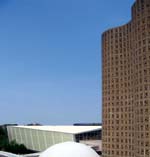 (Polshek Partnership Architects) New York Hall of Science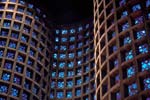 (Polshek Partnership Architects) 5,400 rectangular coffers studded with shards of blue glass form the walls of Harrison’s Great Hall.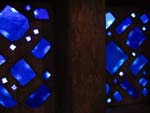 Glass coffer detail Glass coffer detail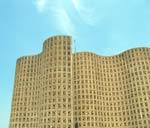 (Polshek Partnership Architects) Exterior detail, 1964 Hall of Science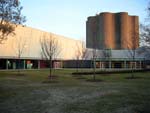 (Polshek Partnership Architects) North elevation shows the connection between the new northern addition (the Hall of Light) and the original building.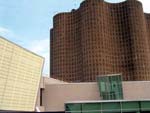 (Polshek Partnership Architects) Hall of Science exterior with detail of Polshek Partnership’s addition in foreground.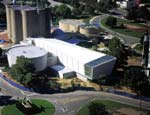 (Steven Turner) Aerial view of the Hall of Science complex |
© 2004 ArchNewsNow.com